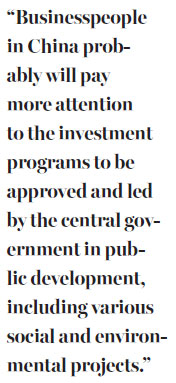Real challenge for new five-year plan
Updated: 2016-03-04 07:59
By Ed Zhang(China Daily Europe)
|
|||||||||
Private capital needs to be funneled to public projects - and public-private partnerships are a likely solution
The first couple of weeks in March is the time for China's two sessions: the annual meetings of the legislature, the National People's Congress, and the top advisory body, the Chinese People's Political Consultative Conference.
This year's sessions are particularly important because they will finalize the 13th Five-Year Plan (2016-20), which will guide the historic transition of the world's second-largest economy.
People hold different opinions as to what should be most attentively watched in the plan.

Some say it's consumption, or the spending power of what would be the largest group of middle-class consumers in the world from now to 2020. It is a change that has a wide and varied influence. Hardly any country, as one economist said recently, is ready to receive and accommodate the increasing swarms of Chinese tourists.
Businesspeople in China probably will pay more attention to the investment programs to be approved and led by the central government in public development, including various social and environmental projects. They are expected to involve an immense amount of capital commitment and many large orders - from new cities to new mass transit systems.
But neither of the above is the most crucial. Actually, one doesn't have to peruse the 13th Five-Year Plan to know the answers. It takes only common sense to tell that in the next few years, China will probably produce the world's largest group of middle-class consumers and largest public projects.
The real challenge is whether China can find new areas of growth, and guide its society's money to those areas.
This is a time of a flood of credit and a famine of success, or industries of exponential growth, as the Internet once was. The long lines of people waiting overnight to buy new luxury homes in Shanghai, which Chinese media reported recently, vividly reflect the amount of idle money in society and the urge among investors to hunt for profitable assets.
It's good to have some rich people in society, but they can wreak havoc on an economy if many of them don't know how they can work with the rest of society and usefully invest their money.

Some wealthy Chinese made more money from credit to bail out the economy after the global financial crisis in 2008. But their old ways of business are no longer working. Many things, like running a small steel mill or coal mine, are no longer profitable or permitted by law. Coal prices have, for example, fallen by more than half from 2011 levels.
Even more industrial operations, the making of practically anything that can no longer sell, are to be phased out and closed down in the next few years.
When uncertainty abounds in the securities market, and there is not much to expect from the exchange market, all they can do, rather helplessly, is buy one new piece of property.
Up to now, China is still fumbling for ways to guide society's abundant capital, especially that of the private sector, toward projects that governments cannot undertake single-handedly, and thereby serve public purposes.
So the really important challenge for the 13th Five-Year Plan is how to help private and corporate money contribute to the public and society's sustainable development. To meet the challenge, a likely solution is public-private partnerships.
In theory, such partnerships can be realized through joint investment (and shared ownership) by government and private entities, and through government procurement of private-sector entities in the provision of public services. The next stage of the nation's urban development will be impossible if it relies entirely on government efforts.
One example could be the development of underground tunnels - for drainage, gas pipes and cable networks - in all newly built cities that still lack them. There are so many new cities and urban districts that some economists estimate that this undertaking alone would require an annual investment of up to 1 trillion yuan ($152 billion; 140 billion euros) over the next few years, one-60th of the nation's GDP.
Where so much money can come from remains a question unless there is a political guarantee for widespread use of PPPs on different levels of the government. As it were, the 13th Five-Year Plan is China's first about PPPs.
The author is editor-at-large of China Daily. Contact the writer at edzhang@chinadaily.com.cn
Today's Top News
Inspectors to cover all of military
Britons embrace 'Super Thursday' elections
Campaign spreads Chinese cooking in the UK
Trump to aim all guns at Hillary Clinton
Labour set to take London after bitter campaign
Labour candidate favourite for London mayor
Fossil footprints bring dinosaurs to life
Buffett optimistic on China's economic transition
Hot Topics
Lunar probe , China growth forecasts, Emission rules get tougher, China seen through 'colored lens', International board,
Editor's Picks

|

|

|

|

|

|







